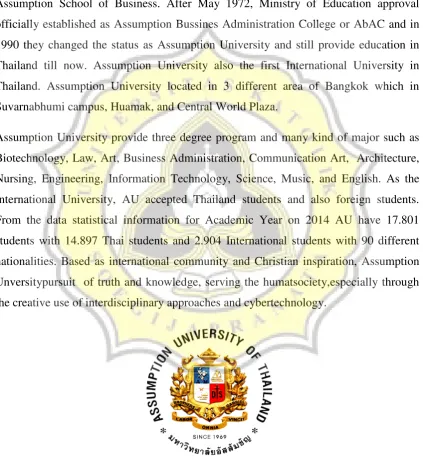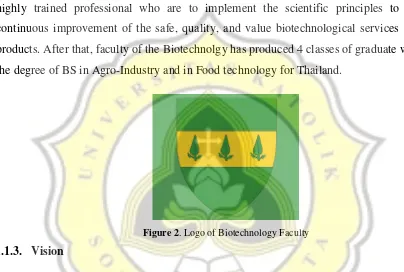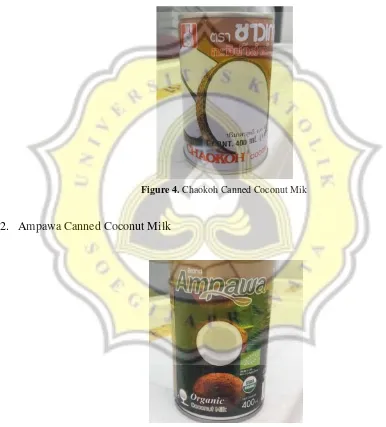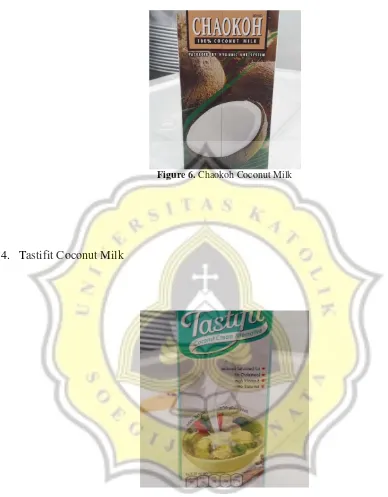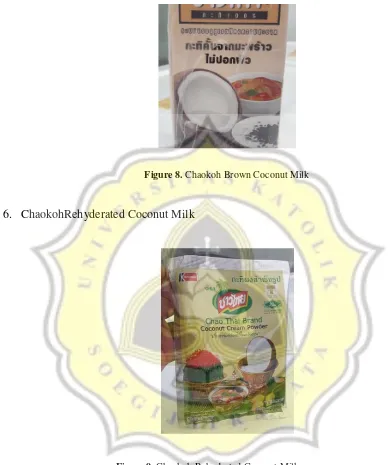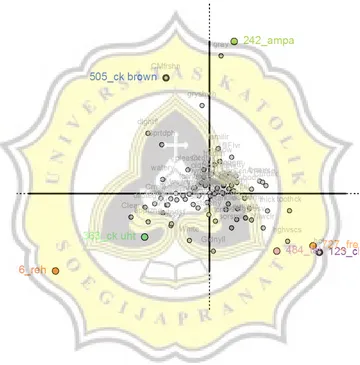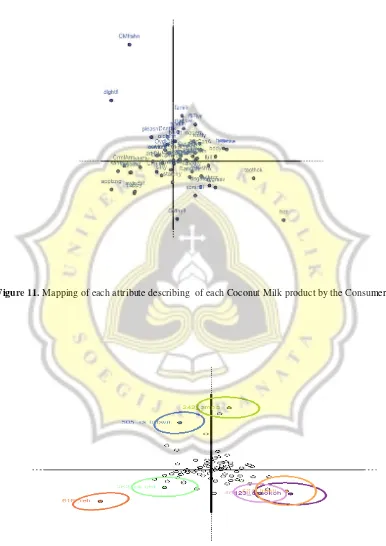PROFILLING OF COCONUT MILK PRODUCT
PRACTICAL TRAINING REPORT
This practical training report is submitted for the partial requirement
for Bachelor Degree
By :
Nazhifa Salsabila
14.I1.0216
DEPARTMENT OF FOOD TECHNOLOGY
FACULTY OF AGRICULTURAL TECHNOLOGY
SOEGIJAPRANATA CATHOLIC UNIVERSITY
SEMARANG
iv PREFACE
Gratitude belongs only to the Almighty One, who has given His blessing to the author for taking the time to complete this practical training report entitled “Profilling of Coconut Milk Product” This practical training report is submitted to fulfill one of the requirements to gain bachelor degree of Agricultural Technology Faculty, Food Technology Department, Soegijapranata Catholic University.
In finishing this report, the writer really gives regards and thanks for people who has given guidance and help; they are:
1. Dr. Tatsawan Tipvarakarnkoon, the advisor, who has given her best guidance for this practical training, from conducting the test until finishing paper.
2. Dr. A. Rika Pratiwi, Msi , 2nd
3. Dr. ChurdcaiCheowtirakul, Dean of Faculty of Biotechnology, Assumption University, who has given the opportunity to carry on the practical training in his faculty.
advisor, who has also given his best support and guiding together for this practical training, from the beginning until it has finished.
4. Dr. V. Kristina Ananingsih, ST., MSc., Dean of Faculty of Agricultural Technology, Soegijapranata Catholic University, for giving the information and chance to join the practical training abroad.
5. My family, parents, Aris Sukarno, Tinon Martanita, my younger brother, Fathan Adyatma, for always being number one supporter and saying my name in every prayer.
6. Kenny, Onny, and Lina who has giving support, help, and being been best practical training mates during the process.
7. Shauma, Belle, Della, and Geo who always support and help during the process 8. All people who has directly and indirectly helped during the practical training until
finishing the report.
made as one of the good examples for the next practical training. Big hope from the writer that this report can be useful for others.
Semarang, July 4th Writer
v
CONTENTS
TITLE ... i
APPROVAL PAGE ... ii
PREFACE ... iii
CONTENTS ... v
LIST OF TABLES ... vi
LIST OF FIGURES ... vii
1. INTRODUCTION ... 1
1.1.Profile of The Institution ... 1
1.2.Purpose of Practical Training ... 4
1.3.Time and Place of Practical Training ... 4
2. RESEARCH BACKGROUND ... 5
3. RESEARCH METHODOLOGY ... 9
3.1.Materials ... 9
3.2.Methods ... 12
4. RESULTS AND DISCUSSION ... 13
4.1.Processed Thailand Coconut Milk ... 14
4.2.Savory Thailand Coconut Milk ... 18
5. CONCLUSION ... 20
6. REFERENCES ... 21
vi
LIST OF TABLE
vii
LIST OF FIGURES
Figure 1. Logo of Assumption University of Thailand ... 1
Figure 2. Logo of Biotechnology Faculty ... 2
Figure 3. Map of Assumption University, Hua Mak, Bangkok ... 4
Figure 4.Chaokoh Canned Coconut Milk ... 9
Figure 5. Ampawa Canned Coconut Milk ... 9
Figure 6. Chaokoh Coconut Milk ... 10
Figure 7. Tastifit Coconut Milk ... 10
Figure 8.Chaokoh Brown Coconut Milk ... 11
Figure 9.Chaokoh Rehydrated Coconut Milk... 11
Figure 10. Processed Coconut Milk Mapping. ... 15
Figure 11.Processed Coconut Milk Mapping. ... 16
Figure 12. Processed Coconut Milk Mapping. ... 16
Figure 13. Explained Variance of Processed Coconut Milk ... 17
Figure 14. Explained Variance of Processed Coconut Milk. ... 17
Figure 15.Savory Thailand Coconut Milk Mapping. ... 18
Figure 16.Savory Thailand Coconut Milk Mapping ... 19
Figure 17.Savory Thailand Coconut Milk Mapping. ... 19
Figure 18. Explained Variance of Savory Coconut Milk. ... 20
1 1. INTRODUCTION
1.1. Profile of The Institution 1.1.1. Assumption University
Assumption University (AU) is a private-based Catolic University in Thailand that administrated by the Brotheers of St. Gabriel. Assumption University was built on 1969 which originated from Assumption Comercial College with under the name of Assumption School of Business. After May 1972, Ministry of Education approval officially established as Assumption Bussines Administration College or AbAC and in 1990 they changed the status as Assumption University and still provide education in Thailand till now. Assumption University also the first International University in Thailand. Assumption University located in 3 different area of Bangkok which in Suvarnabhumi campus, Huamak, and Central World Plaza.
Assumption University provide three degree program and many kind of major such as Biotechnology, Law, Art, Business Administration, Communication Art, Architecture, Nursing, Engineering, Information Technology, Science, Music, and English. As the International University, AU accepted Thailand students and also foreign students. From the data statistical information for Academic Year on 2014 AU have 17.801 students with 14.897 Thai students and 2.904 International students with 90 different nationalities. Based as international community and Christian inspiration, Assumption Unversitypursuit of truth and knowledge, serving the humatsociety,especially through the creative use of interdisciplinary approaches and cybertechnology.
1.1.2. Faculty of Biotechnology
The Faculty of Biotechnology was estabilished in 1993 and it’s the ninth faculty in Assumption University which produce graduates working in biotechnology field and its related fields. Faculty of Biotechnolgy of Assumption University has provided two bachelors program in Agro Biotehnology and Food Biotechnology with 4-year studies. Since 1997, the aceademicstandart of both of the program already approved by the Ministry of University Affairs. The Faculty objective is to provide the nation with highly trained professional who are to implement the scientific principles to the continuous improvement of the safe, quality, and value biotechnological services and products. After that, faculty of the Biotechnolgy has produced 4 classes of graduate with the degree of BS in Agro-Industry and in Food technology for Thailand.
Figure 2. Logo of Biotechnology Faculty
1.1.3. Vision
To be the leading international biotechnology school developing human resources and expanding and transferring knowledge for continuous improvement of the safety, quality and value of agricultural and food products through the excelling in the creation of new knowledge and application in Biotechnology appropriated for development of the country/community.
1.1.4. Mission
1. Providing exemplary educational opportunities that will prepare students to contribute to a dynamic, diverse and global society and pursue lifelong learning; 2. Use the best-suited scientific tools and systems to solve both fundamental and
3. Improve competitiveness and profitability of growers and processors of fruit and vegetable crops, animals, and other expanding agro industries;
4. Develop and implement food biotechnologies to ensure the wholesomeness of foods;
5. Improving individual, family and community well-being through the discovery and dissemination of knowledge in the agricultural, food systems, life and environmental sciences;
6. Providing knowledge in the biological, physical and social sciences necessary to optimize the profitability, sustainability and productivity of the country’s agricultural resources while fostering stewardship of natural and human resources;
7. Help create, attract, and retain agricultural, food, and biotechnology enterprises between international countries.
8. Addressing the role of the Assumption University in enhancing and developing student and industry interactions as a viable part of the global economy.
1.1.5. Strategic Goals
1. Students are competent human resources who responsibly contribute to a dynamic and diverse society and appreciate different cultures.
2. Students and faculty members are able to create, transfer and expand knowledge through research development in biotechnology, food technology and agro-industry to solve problems pertaining agriculture and food science for a well-being of the country.
1.1.6. Faculty Members
1.1.6.1. Administrators
The main administrators of the faculty are in follow:
• Dr. ChurdchaiChowtirakulas Dean and Director of Ph.D. program in Food Biotechnology
4
• Dr. AussamaSoontrunnarudrungsrias Chairperson of Department of Food
Technology
• Dr. PrathipChiaravanond as Chairperson of Agro-Industry Technology Departement
1.1.6.2. Instructors
In academic year 2005, the Faculty of Biotechnology has 19 full-time instructors, three teaching assistants, one administrative staff and two laboratory technicians. The faculty also invited 14 part-time qualified instructors to teach the students from 1st year to 4th
• Full time instructor Ph.D.: MS : BS = 3:13:3
year. Academic ratios of the full-time instructors and part time instructor in 2004 are as follows.
• Part time instructor Ph.D.: MS : BS = 5:8:0
1.2. Purpose of Practical Training
• To give the student an experience to deal with food research, so that the
student can implement the knowledge that was learned in the real industrial or scientific world.
• To give the student an opportunity to adapt with new culture and society. • To broaden the student’s knowledge and experience in the international
exposure.
1.3.Time and Place of Practical Training
The practical training was performed at the Faculty of Biotechnology, Assumption University Hua MakCampus, Bangkok, Thailand, in 10th January to 10th March 2017.
6
2. BACKGROUND RESEARCH
Coconut (Coconucifera L.) is belong to the palm family (Arecaceae). Coconut itself commonly used as source of coconut oil, milk and cream products which can be processed as coconut milk product such as coconut water and coconut milk (Borgeset. al, 2012). From Seow and Gwee (1997) said that coconut milk itself is extracted from endosperm of mature coconut with the natural oil-in-water emulsion. In general, coconut milk can be described as milky white juice by pressing the grated coconut flesh with or without added water. It has important role in many tradition food especially in Asia regions (Chiewchanet al., 2006). Coconut milk naturally contain stabilized coconut protein such as globulin and albumin which present in aqueous phase of the coconut milk with fat globules and act as emulsifier by surrounding its surface (Peamprasart and Chiecham, 2006). Many valiant attemps are being made commercially, to extend the shelflife of coconut milk by canning, aseptic packaging and spray drying (Seow and gwee, 1997).
The food and beverage sector contributes to the Thai national income, employment, value added inducement and foreign exchange earning. Thailand food industry provides the employment to approximately 600,000 people. As the sole net food exporter in Asia and has the capacity to produce far than its consumes, Thaliand’s food industries have developed rapidly throughout the past decade and is one of the most developed in South East Asian region (Rodmaneeand Huang, 2013).
Based with Meilgaardet al.(2006), sensory testing have primary funcition to provide reliable data on which sound decisions may be made and using sensory profiling could be important tool in the food industry since it is generally used for new product development, maintance of product and marketing strategies defintion. The Sensory Test has three important advantages: it identifies the presence of notable differences, identifies and quantifies important sensory characteristics in a fast way, and identifies specific problems that cannot be detected by other analytical procedurs, as consumer preference, for instance (Nakayama and Wessman, 1979). Nowdays, demands of sensory methodology and technology have grown tremendously around the world, most sensory test have been developed. Recent year, technique of sensory profiling have been developing with the help of untrained assesors or consumers and studied in order to overcome some limitations of descriptive analysis (Valentin et al. 2012; Varela and Ares, 2012). The example of those sensory profiling methods are sorting, flash profile, projective mapping and Check-All-That-Apply questions (CATA) (Adams et al. 2007). In this study, the method we used are Check-All-That-Apply or CATA.
8
CATA is different from scaling in the sense that no intensities are given to the attributes. In addition, the descriptors are not constrained to product sensory attributes but also be related to product usage or concept fit. CATA Sensory also provides in information which attributes are detectable according the panelist and how how may relate to their overall liking and acceptance. This sensory also can help the new development of new product since CATA response are directly linked to consumer perception.However, CATA question list for these test for both of session are presented in ‘fixed’ or same order for all products and satisfying behaviour of consumer panelist might be affecting the data of drivers liking that may not be stable.
The main goal of this study are:
9
3. RESEARCH METHODOLOGY
3.1. Materials
The materials that used in this research was Thailand Coconut Milk. Other ingredients for sampe was Fresh Coconut Milk that purchased from local grocery store. The products categories and samples used in this study are listed below.
• Thailand Coconut Milk :
1. Chaokoh Canned Coconut Milk
Figure 4. Chaokoh Canned Coconut Mik
2. Ampawa Canned Coconut Milk
3. Chaokoh Coconut Milk
Figure 6. Chaokoh Coconut Milk
4. Tastifit Coconut Milk
5. Chaokoh Brown Coconut Milk
Figure 8. Chaokoh Brown Coconut Milk
6. ChaokohRehyderated Coconut Milk
3.2.Methods
3.2.1. Sample Preparation
The sample used for each categories were commercially available both in Thailand and Indonesia. In this study, there are 4 sensory session with 4 different kinds of sample. The first sample is Curry Coconut Milk using Thailand Coconut Milk. The second sample for second sensory is Thailand Processing Coconut Milk.
3.2.1.1.Curry Coconut Milk Preperation
First, Measure coconut milk with certain weight before separate it for 20% and 60% volume of the measured coconut milk. After that, prepare the paste which weight of 10% used coconut milk and add them with 20% coconut milk then mixed well. Mix them until 1 minute and the colour turns to be yellow. Then, add sugar which weight of 8% from the used coconut milk and 5% percentage of fish sauce from the coconut milk. Last, cooked it until it reach 90°C for 2 minute. The final of curry coconut milk sample placed in a small circular cups with 3- digit code and arranged in random order.
3.2.1.2.Processing Coconut Milk Preperation
Thailand Coconut Milk were poured in a small circular coups with 3- digits code and arrange in random order.
3.2.2. Participants
13
3.2.3. Consumer Tests 3.2.3.1. Sensory Test
This study were taking place in Sensory Laboratorium, E5, Assumption University, Hua Mak Campus which designed based ISO 8589 (ISO 2007) and performed under artificial daylight-type illumination, temperature control (between 22 and 24°C) and air circulation.
The panelist of the sensory were the consumers who usually consumed coconut milk and asked to taste and evaluate the sample. Coconut milk sample were prepared in available cups with 3-digit code and placed in tray. Each consumer would have seven samples of products. The order of the samples given was randomized so consumer would have no idea what is the first or second sample they evaluated, and the bias could be minimized.Costumers should answer and check the attributes in the questonaire based on their opinion of the sample.
3.2.3.2. Data Analysis
14 4. RESULTS AND DISCUSSION
The high level of consumption in Thailand society including processed coocnut milk which is recorded base on statistics result conducted by Thai Minisitry Agriculture and Coorperative spur the producers to develop processed coconut products. In daily life, thare many of coconut processed products which easily to found and to become one of the main ingredients with mixed in the daily food consumption by Thailand citizen because of savory taste also coconut their sweet taste. There are plenty different of commercial coconut milk product with using different technique such as UHT, sterilization, pasteurization, and spray drying method.
In this study, there were 50 consumers who particaipated in each CATA Sensory. Based on (Macfie&Hedderley, 2005), in CATA Sensory the consumer is allow to choose any word or a few word how they describe the product and after that the attributes can be evaluated which the result will be less exepensive and the data of the consumer acceptance and percepetion view will be more accurate. For this study, the consumer who is doing sensory are untrained panelist however, based from (Benedito, Cárcel, &Mulet, 2001; Guerrero, Gou, &Arnau, 1997;Husson &Pagés, 2003; Lelievre, Chollet, Abdi, & Valentin, 2008), in the study shown that there is only minimal difference between used trained and untrained panelist. For this research, there are two different sensory which are Original and Savory Thailand Coconut milk and from the result can be analysis how well the Thailand people described their Thailand Coconut Milk.
4.1.Processed Thailand Coconut Milk
For the Processed Thailand Coconut Milk sensory, the sensory code of the sample product are shown in Table 1.
Table 1. Processed Thailand Coconut Milk code product list.
Code Product Product Name
123 Chaokoh Canned Coconut Milk
242 Ampawa Canned Coconut Milk
15
484 Tatsifit UHT Coconut Milk
505 Chaokoh Brown Coconut Milk
616 Chaokoh Rehydrated Coconut Milk
727 Fresh Coconut Milk
Fig 10. Multiple factor analysis Thailand Coconut Milk using consumer CATA counts. Products codes are listed in Table 1.
and Chaokoh Rehydrated Coconut Milk were characterized by CATA counts for the second dimension.
Figure 11. Mapping of each attribute describing of each Coconut Milk product by the Consumer.
Overall, the customer represent each product differently as shown in Figure 12. The AmpawaCanned product which located in second dimension was remembered by costumer for the gray colour and Chaokoh Brown UHT represent by their freshness. For Chaokoh UHT was represent represent by appetizing and sweet flavor. Three product which placed as the same group Chaokoh Canned, TatsifitUHT ,and Fresh Coconut Milk mainly characterized by the sensory attributes of high viscous coconut milk by consumer.
The results of external preference mapping using CATA counts are grapichally shown in Figs. 12. There are five groups of product charactergorized in this result which are group one consist of Ampawa Coconut Milk, group two consist of Chaokoh Brown Coconut Milk, group three consists of Chaokoh UHT Coconut Milk, group four consists of Chaokoh Rehydrated Coconut Milk, and Chaokoh Canned Coconut Milk ,Tastifit Coconut Milk,Fresh Coconut Milk formed a fifth group which characterized by the panelist high viscous coconut milk. Also, Chaokoh Canned and Tastifit have the similar taste from fresh coconut milk which coconut milk used as the control. Hence, Chaokoh Rehydrated indicated that they were well describedby their characteristics as similar attributes as Chaokoh UHT but the Rehydrated is more intense in some attributes than Chaokoh UHT since as shown in the figure since the line of the figure not close to the line.
Fig 13 and 14. Explained Variance per Dimension of Thailand Coconut Milk processed with R-program.
4.2.Savory Thailand Coconut Milk
For the Savory Thailand Coconut Milk, the sensory code of sample product are shown in Table 2.
Table 2. Savory Thailand Coconut Milk code product list.
Code Product Product Name
093 Chaokoh Canned Coconut Milk
948 Ampawa Canned Coconut Milk
803 Chaokoh UHT Coconut Milk
658 Tatsifit UHT Coconut Milk
771 Chaokoh Brown Coconut Milk
110 Chaokoh Rehydrated Coconut Milk
Fig 15. Multiple factor analysis Savory Thailand Coconut Milk using consumer CATA counts. Products codes are listed in Table 2.
19
werecharacterized for the first dimension since close to line. On other hand, Chaokoh UHT, Chaokoh Canned, Chaokoh Brown UHTresult showed the samples were characterized as second dimension.
Figure 16. Mapping of each attribute describing of each Coconut Milk product by the Consumer.
Figure 17. Results of preference mapping of Savory Thailand Coconut Milk Product.
ChaokohCanned, panelist considered the product by their caramel colour and in Ampawa Canned product recognized have modern atributes. Both for Chaokoh Brown and Chaokoh UHT have known by their sour attributes. As for the Chaokoh Rehydrated many of thepanelist checked for the full and silky attributes for their particular characteristic. However, in the mapping analysis data for Tatsifit UHT, it conclude that the product does not have a distinctive attributes by the panelist after tasting the savory product using Tatsifit UHT.
Fig 18 and 19. Explained Variance per Dimension of Savory Thailand Coconut Milk processed with R-program.
The explained variance per dimension scored of 6 samples Savory Thailand Coconut Milk was shown in figure 4 and figure 5. From the graphic, there is a decrease in the percent value of each dimension increase whereas in the dimensions of one percentage number denotes a figure of about 38% and for dimensions 2 percentage of about 20-25%. This result indicates that there is no significally different between first dimensions and second dimensions.
Based on the Check-All-That-Apply sensory results between Thai Sensory Coconut Milk
Original and Savory Thai Coconut Milk , result showed that many panelists have described
the character of same Thailand coconut milk product in separate two sensory differently such
as for example the panelists describe Chaokohas high viscous but in Savory Coconut Milk
characterized by caramel colour. According to Sudman and Bradburn (1982) the difference
might be shown when the panelist are required to select the character of the attributes it can
be some uncertainty for choosing what attribute is suitable to describe the sample of coconut
milk or since the benefit of CATA panelist can choose the attributes freely so in sometime
they prefer to be neutral or not choose the appropate characteristic for the sample. Then, the
21
so that the panelist can feel fatigue and complacency. Another factor of the bias sensory
characterist is the number of untrained panelists used in the first sensory can respond the free
test incorrectly so it requiring prior or warm up sample training before the actual test
(Wakeling and Macfire, 1995).
On the other hand, result from CATA sensory make it easy to know the attributes of the characteristic of coconut milk product that can be done easily only with checking the mark of attributes so using this information can know the category of product favored by people in Thailand. This informantion can be benefit for the product development in Thailand which can increase the consumption rate of coconut milk.
5. CONCLUSION
One of the sensory techniques, CATA, is one of the easiest sensory and can be completed
very quickly with trained or untrained panelist to check all the atributes of the sample based
on their preference. In this study, coconut milk, our panelist finds that every coconut milk
product hassignificant attributes ehich different from others. However, in this study after
sampe prepared using the formulation of the samples, the results showed that the panelists
rate the characteristics of the same coconut milk product having distinctattributes after
formulation. It might be happen because of several factors, such as panelists can not decide
on the right attributes because they have not be trained or simply choose originally because of
disadvantage in CATA which the panelists given the freedom to choose attributes on the
sample. However, this result of the attributes of coconut milk can be theinformantionwould
be the benefit for the product development in Thailand which can increase the consumption
22 6. REFERENCE
Abdi, H., & Valentin, D. (2007). Multiple factor analysis (MFA). In N. Salkind (Ed.), Encyclopedia of measurement and statistics. Thousand Oaks, CA: Sage Publications
Benedito, J., Cárcel, J. A., &Mulet, A. (2001). Cheese hardness by experts anduntrained judges.Journal of Sensory Studies, 16, 277–285
C Borges; B Bjorn; D Petr. (2012). Food Research International, 47: 146–151
Chiewchan, Naphaporn, Luxsika Ngamwonglumlert abd Sakamon Devahastin. (2016) Effect of pretreament and drying methods on molecular structure, functional properties and thermal stability of fibre powder exhibiting colour from Centella asiatica L. Volume 51, Issue 3, pages 753-764, March 2016.
Deliza, R., Macfie, H., & Hedderley, D. (2005). The consumer perception of passion-fruit juice using free choice profiling.Journal of Sensory Studies, 20, 17–27
Dooley, Lauren, Yong-Seung Lee, and Jean- Francois Meullenet. (2010).The application of check-all-that-apply (CATA) consumer profiling to preference mapping of vanilla ice
cream and its comparison to classical external preference mapping. Volume 21, Issue 4,
June 2010, Pages 394-401
Guerrero, L., Gou, P., & Arnau, J. (1997). Descriptive analysis of toasted almonds: A comparison between expert and semi-trained assessors. Journal of Sensory Studies, 12, 39–54
Husson, F., & Pagés, J. (2003). Comparison of sensory profiles done by trained and untrained juries: Methodology and results. Journal of Sensory Studies, 18,453–464
J. Adams, A. Williams, B. Lancaster, M. Foley (2007) Advantages and uses of
check-all-that-apply response compared to traditional scaling of attributes for salty snacks. 7th
Pangborn Sensory Science Symposium. Minneapolis, USA, 12–16 August, 2007 (2007)
23
Lelievre, M., Chollet, S., Abdi, H., & Valentin, D. (2008). What is the validity of the sorting task for describing beers? A study using trained and untrained assessors. Food Quality and Preference, 19, 697–703
Morten C.Meilgaard
Nakayama, Michiko and Collen Wessman. (1979). Application of sensory evaluation to the
routine maintance of product quality.Food Technology: Agris.
, B. Thomas Carr, Gail Vance Civille. (2016). Sensory Evaluation
Techniques, Fourth Editionby CRC Press
Seow, C. C., &Gwee, C. N. (1997). Coconut milk: chemistry and technology. International Journal of Food Science and Technology, 32, 189–201
Sudarin Rodmanee and Wen-Chi Huang, (2013).Efficiency Evaluation of Food and Beverage
Companies in Thailand: An Application of Relational Two-Stage Data Envelopment
Analysis," International Journal of Social Science and Humanity vol. 3, no. 3, pp.
202-205,
Sudman, S., & Bradburn, N. M. (1982).Asking questions. San Francisco, CA: Jossey-Bass.
T. Peamprasart, N. Chiewchan, J. Food Eng. 77, 653- 658 (2006)
Valentin, D., Chollet, S., Leli`evre, M., & Abdi, H. (2012). Quick and dirty but still pretty good: A review of new descriptive methods in food science. International Journal of Food Science & Technology, 47, 1563–1578.
Varela, P., Ares, G. (2014). Novel Techniques in Sensory Characterization and Consumer Profiling. Boca Raton: CRC Press.
24
ORIGINAL THAILAND COCONUT MILK SENSORY EVALUATION
Consumer No. _____________ Sample No.
______________
This questionnaire is designed for a research entitled, ‘Profiling of coconut milk’, in partial fulfilment data of the research. This research aims
is tosurvey the pattern of coconut milk consumption and
to discover the extent to which the consumers perceive and accept the product.Instruction: Please taste the samples; remember to rinse your palate with water or saltine crackers before tasting the other. Please put a check mark (✓) on the box that corresponds to your answer.
1. Please check all the terms that describe the sample’s appearanc Yellow color Separated-phase Low viscous Grayish White
Gray
High viscous
2. Please check all the terms that describe the sample’s aroma Overall coconut milk aroma
attributes.
Coconut milk sweet aroma
Coconut meat / Coconut milk freshness
Rancid
Caramel aroma
Coconut Flake Aroma
25
3. Please check all the terms that describe the sample’s flavor and taste Salty
attributes.
Sweet Rancid
Cooked Oil Aroma Coconut Milk Fresh Caramel Flavor
Cooked Flavor
Sour
Nutty
Overall Coconut Milk Flavor Full flavor
Light Flavor
Burnt Very Spicy Mild Spicy
Coconut milk sweet flavor Off flavor
Coconut flake flavor
4. Please check all the terms that describe the sample’s mouthfeel Creamy
attributes.
Watery Oily
Oily moutg creating watery
Too thick
5. Please check all the terms that describe your emotion Happy
after tasting the attributes.
26
SAVORY THAILAND COCONUT MILK SENSORY EVALUATION
Consumer No. _____________ Sample No.
______________
This questionnaire is designed for a research entitled, ‘Profiling of coconut milk’, in partial fulfilment data of the research. This research aims is to survey the pattern of coconut milk consumption and to discover the extent to which the consumers perceive and accept the product.
Instruction: Please taste the samples; remember to rinse your palate with water or saltine crackers before tasting the other. Please put a check mark (✓) on the box that corresponds to
your answer.
1. Please check all the terms that describe the sample’s appearance Yellow color
2. Please check all the terms that describe the sample’s aroma Overall coconut milk aroma
attributes.
Coconut milk sweet aroma
Coconut meat / Coconut milk freshness
Rancid
Caramel aroma
Coconut Flake Aroma
27
Cooked aroma
Young Coconut Aroma Cooked Oil
3. Please check all the terms that describe the sample’s flavor and taste Salty
attributes.
Sweet Rancid
Cooked Oil Aroma Coconut Milk Fresh Caramel Flavor
Cooked Flavor
Sour
Nutty
Overall Coconut Milk Flavor Full flavor
Light Flavor
Burnt Very Spicy Mild Spicy
Coconut milk sweet flavor Off flavor
Coconut flake flavor
4. Please check all the terms that describe the sample’s mouthfeel Creamy
attributes.
Watery Oily
Oily moutg creating watery
Too thick
5. Please check all the terms that describe your emotion Happy
after tasting the attributes.

